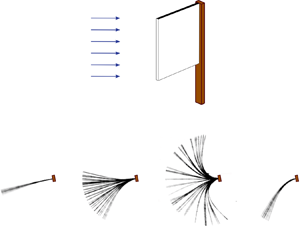Article contents
Dynamics of an inverted cantilever plate at moderate angle of attack
Published online by Cambridge University Press: 29 December 2020
Abstract

The dynamics of a cantilever plate clamped at its trailing edge and placed at a moderate angle ( $\alpha \leq 30^{\circ }$) to a uniform flow are investigated experimentally and numerically, and a large experimental data set is provided. The dynamics are shown to differ significantly from the zero-angle-of-attack case, commonly called the inverted-flag configuration. Four distinct dynamical regimes arise at non-zero angles: a small oscillation around a small-deflection equilibrium (deformed regime), a small-amplitude flapping motion, a large-amplitude flapping motion and a small oscillation around a large-deflection equilibrium (deflected regime). The small- and large-amplitude flapping motions are shown to be produced by different physical mechanisms. The small-amplitude flapping motion appears gradually as the flow speed is increased and is consistent with a limit-cycle oscillation caused by the quasi-steady fluid forcing. The large-amplitude flapping motion is observed to appear at a constant critical flow speed that is independent of angle of attack. Its characteristics match those of the large-amplitude vortex-induced vibration present at zero angle of attack. The flow speed at which the plate enters the deflected regime decreases linearly as the angle of attack is increased, causing the flapping motion to disappear for angles of attack greater than
$\alpha \leq 30^{\circ }$) to a uniform flow are investigated experimentally and numerically, and a large experimental data set is provided. The dynamics are shown to differ significantly from the zero-angle-of-attack case, commonly called the inverted-flag configuration. Four distinct dynamical regimes arise at non-zero angles: a small oscillation around a small-deflection equilibrium (deformed regime), a small-amplitude flapping motion, a large-amplitude flapping motion and a small oscillation around a large-deflection equilibrium (deflected regime). The small- and large-amplitude flapping motions are shown to be produced by different physical mechanisms. The small-amplitude flapping motion appears gradually as the flow speed is increased and is consistent with a limit-cycle oscillation caused by the quasi-steady fluid forcing. The large-amplitude flapping motion is observed to appear at a constant critical flow speed that is independent of angle of attack. Its characteristics match those of the large-amplitude vortex-induced vibration present at zero angle of attack. The flow speed at which the plate enters the deflected regime decreases linearly as the angle of attack is increased, causing the flapping motion to disappear for angles of attack greater than  $\alpha \approx 28^{\circ }$. Finally, the effect of aspect ratio on the plate dynamics is considered, with a plate of reduced aspect ratio being shown to lack a sharp distinction between flapping regimes for
$\alpha \approx 28^{\circ }$. Finally, the effect of aspect ratio on the plate dynamics is considered, with a plate of reduced aspect ratio being shown to lack a sharp distinction between flapping regimes for  $\alpha >8^{\circ }$.
$\alpha >8^{\circ }$.
JFM classification
Information
- Type
- JFM Papers
- Information
- Copyright
- © The Author(s), 2020. Published by Cambridge University Press
References
REFERENCES
Huertas-Cerdeira et al. supplementary movie 1
Motion of an inverted cantilever plate in the deformed regime. Images obtained experimentally for an aspect ratio of AR=5, and angle of attack of α=10° and a non-dimensional flow speed of √κ=0.96.
Huertas-Cerdeira et al. supplementary movie 2
Motion of an inverted cantilever plate in the small-amplitude flapping regime. Images obtained experimentally for an aspect ratio of AR=5, an angle of attack of α=10° and a non-dimensional flow speed of √κ=1.72.
- 9
- Cited by


